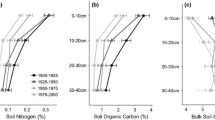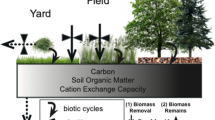Abstract
We assessed biogeochemical cycling of elements through residential household landscapes to evaluate the importance of annual to decadal household-level decisions for element fluxes that contribute to urban and regional pollution. We combined a mailed survey, vegetation measurements, and allometric and biogeochemical models to estimate fluxes and accumulation of carbon (C), nitrogen (N), and phosphorus (P) in landscapes of 360 single-family homes in the Minneapolis-Saint Paul, Minnesota metropolitan area. Carbon inputs and accumulation were strongly influenced by the presence of trees on the property. Nitrogen inputs to the landscape exceeded estimated ecosystem demand for N on average by 51% and were dominated by N fertilizer application. Because Minnesota state law restricts the use of P fertilizer, pet waste was responsible for 84% of P inputs to the landscape. The results have implications for understanding sources of urban pollution and the potential flexibility (i.e., the potential for change) in household behaviors such as tree planting, fertilization, and pet waste management that contribute to such pollution.




Similar content being viewed by others
References
Akbari H (2002) Shade trees reduce building energy use and CO2 emissions from power plants. Environ Pollut 116:S119–S126
Anderson LM, Cordell HK (1988) Influence of trees on residential property values in Athens, Georgia (U.S.A.): a survey based on actual sales prices. Landsc Urban Plann 15:153–164
Baker LA, Xu Y, Hope D, Lauver L, Edmonds J (2001) Nitrogen mass balance for the central Arizona-Phoenix (CAP) ecosystem. Ecosystems 4:582–602
Baker LA, Wilson BD, Fulton D (2008) Disproportionality as a framework to target nutrient reduction from urban landscapes. Cities and the Environment 1, Article 7, 15 pp. http://escholarship.bc.edu/cate/vol1/iss2/7
Barr Engineering Inc. (2004) Minnesota phosphorus study. Conducted for the Minnesota Pollution Control Agency, St. Paul, MN
Barten JM, Jahnke E (1997) suburban lawn runoff water quality in the Twin Cities metropolitan area, 1996 and 1997. Report to the Suburban Hennepin Regional Park District, Maple Plain, MN
Bijoor NS, Czimczik CI, Pataki DE, Billings SA (2008) Effects of temperature and fertilization on nitrogen cycling and community composition of an urban lawn. Glob Chang Biol 14:2119–2131
Byrne LB (2005) Of looks, laws and lawns: how human aesthetic preferences influence landscape management, public policies and urban ecosystems. In: Laband D (ed) Emerging issues along urban-rural interfaces: linking science and society conference proceedings. Auburn University, Auburn, pp 42–46
Byrne LB, Grewal P (2008) Introduction to ecological landscaping: a holistic description and framework to guide the study and management of urban landscape parcels. Cities Environ 1:1–20
Cheng Z, Richmond DS, Salminen SO, Grewal PS (2008) Ecology of urban lawns under three common management programs. Urban Ecosyst 11:177–195
Christensen A, Weterholm R, Almen J (2001) Measurements of regulated and unregulated exhaust emissions from a lawn mower with and without an oxidizing catalyst: a comparison of two different fuels. Environ Sci Technol 35:2166–2170
Elliott ET (1986) Aggregate structure and carbon, nitrogen, and phosphorus in native and cultivated soils. Soil Sci Soc Am J 50:627–633
Environmental Protection Agency, EPA (2009) National pollutant discharge elimination system (NPDES) factsheet http://cfpub.epa.gov/npdes/stormwater/menuofbmps/index.cfm?action=factsheet_results&view=specific&bmp=4
Fissore C, Baker LA, Hobbie SE, King JY, McFadden JP, Nelson KC, Jakobsdottir I (2011) Carbon, nitrogen, and phosphorus fluxes in household ecosystems in the Minneapolis-Saint Paul, Minnesota, urban region. Ecol Appl 21:619–639
Frank KW, O’Reilly KM, Crum JR, Calhoun RN (2005) The fate of nitrogen applied to a mature Kentucky bluegrass turf. Crop Sci 46:209–215
Groffman PM, Williams CO, Pouyat RV, Band LE, Yesilonis ID (2009) Nitrate leaching and nitrous oxide flux in urban forests and grasslands. J Environ Qual 38:1848–1860
Grove JM, Troy AR, O’Neil-Dunne JPM, Burch WR Jr, Cadenasso ML, Pickett STA (2006) Characterization of households and its implications for the vegetation of urban ecosystems. Ecosystems 9:578–597
Guillard K, Kopp KL (2004) Nitrogen fertilizer form and associated nitrate leaching from cool-season lawn turf. J Environ Qual 33:1822–1827
Hammer RB, Stewart SI, Winkler RL, Radeloff VC, Voss PR (2004) Characterizing dynamic spatial and temporal residential density patterns from 1940–1990 across the Northern Central United States. Landsc Urban Plann 69:183–199
Heckman JR, Liu H, Hill W, Demilia M, Anastasia WL (2000) Kentucky bluegrass responses to mowing practice and nitrogen fertility management. J Sustain Agric 15:25–33
Horgan BP, Branham BE, Mulvaney RL (2002) Mass balance of N-15 applied to Kentucky blue grass including direct measurement of denitrification. Crop Sci 42:1595–1601
Jiang Z, Sullivan WM, Hull RJ (2000) Nitrate uptake and nitrogen use efficiency by Kentucky bluegrass cultivars. Hortscience 35:1350–1354
Jo H-K, McPherson EG (1995) Carbon storage and flux in urban residential greenspace. J Environ Manag 45:109–133
Kaye JP, McCulley RL, Burke IC (2005) Carbon flux, nitrogen cycling, and soil microbial communities in adjacent urban, native, and agricultural ecosystems. Glob Chang Biol 11:575–587
Kobe RK, Lepczyk CA, Iyer M (2005) Resorption efficiency decreases with increasing green leaf nutrients in a global data set. Ecology 86:2780–2792
Kopp KL, Guillard K (2002) Clipping management and nitrogen fertilization of turfgrass growth, nitrogen utilization, and quality. Crop Sci 42:1225–1231
Kussow WR (2004) Phosphorus runoff losses from lawns. Better Crops 88:12–13
Law NL, Band LE, Grove JM (2004) Nitrogen input from residential lawn care practices in suburban watershed in Baltimore County, MD. J Environ Plan Manag 47:737–755
Lohr VI, Pearson-Mims CH, Tarnai J, Dillman DA (2004) How urban residents rate and rank the benefits and problems associated with trees in cities. J Arboriculture 30:28–35
Milesi C, Elvidge CD, Dietz JB, Tuttle BT, Ramkrishna RN, Running SW (2005) Mapping and modeling the biogeochemical cycling of turf grasses in the United States. J Environ Manag 36:426–438
Nelson KC, Grayzeck S, King J, Hobbie S, Baker L, McFadden JP (2008) Our household choices in urban living survey, University of Minnesota, St. Paul. http://www.forestry.umn.edu/People/Nelson/index.htm#choices
Newman EI (1995) Phosphorus inputs to terrestrial ecosystems. J Ecol 83:713–726
Nowak DJ, Crane DE, Stevens JC (2006) Air pollution removal by urban trees and shrubs in the United States. Urban For Urban Green 4:115–123
Nowak DJ, Crane DE, Stevens JC, Hoehn RE, Walton JT, Bond J (2008) A ground-based method of assessing urban forest structure and ecosystem services. Arboriculture Urban For 34:347–358
Osmond DL, Hardy DH (2004) Characterization of turf practices in five North Carolina communities. J Environ Qual 33:565–575
Parker JH (1983) Landscaping to reduce the energy used in cooling buildings. J For 81:82–85
Petrovic AM (1990) The fate of nitrogenous fertilizers applied to turfgrass. J Environ Qual 19:1–14
Petrovic AM, Soldat DJ, Gruttadaurio J, Barlow J (2005) Turfgrass growth and quality related to soil and tissue nutrient content. Int Turfgrass Soc Res J 10:989–997
Qian YL, Bandaranayake W, Parton WJ, Mecham B, Harivandi MA, Mosier AR (2003) Long-term effects of clipping and nitrogen management in turfgrass on soil organic carbon and nitrogen dynamics: the CENTURY Model simulation. J Environ Qual 32:1694–1700
Raciti SM, Groffman PM, Fahey TJ (2008) Nitrogen retention in urban lawns and forests. Ecol Appl 18:1615–1626
Rodin LE, Bazilevich NI (1967) Production and mineral cycling in terrestrial vegetation. Oliver and Boyd, Edinburgh and London
Rosen CJ, Horgan BP (2005) Regulation of phosphorus fertilizer application to turf in Minnesota: historical perspective and opportunities for research and education. Int Turfgrass Sci Res J 10:130–135
Sander H, Polasky S, Haight RG (2010) The value of urban tree cover: a hedonic property price model in Ramsey and Dakota Counties, Minnesota, USA. Ecol Econ 69:1646–1656
Sharma ML, Herne DE, Byrne JD, Kin PG (1996) Nutrient discharge beneath urban lawns to a sandy coastal aquifer, Perth, Western Australia. Hydrogeol J 4:103–117
Simpson JR, McPherson EG (1998) Simulation of tree shade impacts on residential energy use for space conditioning in Sacramento. Atmos Environ 32:69–74
Soldat DJ, Petrovic MA, van Es HM (2009) The effect of soil phosphorus and nitrogen and phosphorus fertilization on phosphorus runoff losses from turfgrass. In: Nett M et al. (eds) The fate of nutrients and pesticides in the urban environment. ACS symposium series, American Chemical Society, Washington, D.C. pp. 97–106
Sussman D (2008) Since dogs do what they do, what can we do to improve the doo-doo situation at dog parks? Supplement to context alumni magazine. Conway School of Landscape Design
Swann C (1999) A survey of residential nutrient behaviors in the Chesapeake Bay. Widener Burrows, Inc. Chesapeake Research Consortium. Center for Watershed Protection, Ellicott City, p 112
Theriault, M, Kestens Y, Des Rosiers, F (2002) The impact of mature trees on house values and on residential location choices in Quebec City. http://www.iemss.org/iemss2002/proceedings/pdf/volume%20due/191.pdf >.
Wollheim WM, Pellerin BA, Vörösmarty CJ, Hopkinson CS (2005) N retention in urbanizing headwater catchments. Ecosystems 8:871–884
Wright IJ et al (2004) The worldwide leaf economics spectrum. Nature 428:821–827
Acknowledgments
This research was supported by the National Science Foundation Dynamics of Coupled Natural and Human Systems Program (BCS-0709581, BCS-0908549, BCS-0908998) and Long-Term Ecological Research Program (DEB-0620652). We thank the large number of homeowners who responded to our survey and gave us permission to make measurements on their property. We thank our geographic information systems and database specialists, Ina Jakobsdottir and A. Slaats, for their invaluable support, our field crew: B. Bobbitt, C. Buyarski, M. Kemp, T. Knudson, P. Koenig, T. Kraft, M. Ranniger, G. Rubenstein, J. Schubert, and A. Thone, and C. Lee, S. Grayzeck, and A. Woodside for survey coordination and data entry. We also thank D. Nidzgorski and S. Panzer Wein for their useful comments.
Author information
Authors and Affiliations
Corresponding author
Rights and permissions
About this article
Cite this article
Fissore, C., Hobbie, S.E., King, J.Y. et al. The residential landscape: fluxes of elements and the role of household decisions. Urban Ecosyst 15, 1–18 (2012). https://doi.org/10.1007/s11252-011-0189-0
Published:
Issue Date:
DOI: https://doi.org/10.1007/s11252-011-0189-0




